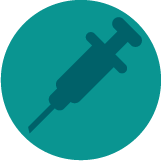REGULATIONS
The importance of good regulation of veterinary medicines
SAFE

A medicine must be safe to use protecting animals, people and the environment.
As with human medicines, many veterinary medicines can have side effects. These must be carefully evaluated and the benefit of using the medicine must strongly outweigh any risks involved with its use. Human safety is always of paramount importance.
Post authorisation surveillance activities relating to the detection, assessment, understanding and prevention of adverse effects, or any other medicine-related problem, provides the basis for continuous benefit/risk assessment.
Food security and adequate nutrition is a basic human right which is reliant on efficient food systems.
Consumer safety for foods derived from animals is ensured by consideration of whether a medicine should be allowed, and if allowed enough time elapses from the time of medicine administration to the time when animal products are obtained, so that any residues of medicines drop to a safe level. This limit is known as the maximum residue limit (MRL) and the necessary time period is known as the withdrawal period. The withdrawal period is specific to each veterinary drug but is only reliable when the veterinary medicine is of a consistent quality, and is administered in a consistent manner, normally as approved during the medicine’s authorisation process.
MEDICINES

All medicines should be manufactured in authorised premises to approved standards.
This ensures that all batches of the product meet the necessary standards and are consistent. These standards, similar to those for human medicines, check among other things that products are sterile if they need to be and that each tablet or bottle contains the correct amount of the active ingredient.
It is important to ensure that the required standards are maintained and that products are being produced, stored and handled properly. There should be effective enforcement processes to detect and address when these standards fall below acceptable levels, and to make sure products can be withdrawn from sale to avoid causing harm.
Medicines should do what they claim to do; as long as the instructions on the label are followed properly and they are given to the types of animal for which they were authorised.
ANIMALS

Livestock are a crucial asset for any country. They play an essential role in creating livelihoods and food security.
Maintenance of terrestrial and aquatic livestock health and welfare requires access to high quality, effective and reliable medicines for prevention and treatment of disease.
Limited access and availability of quality veterinary drugs jeopardise not only livestock productivity through the inability to treat disease resulting in production losses, but also the ability to prevent and contain disease outbreaks including those diseases which can affect people (zoonoses).
Antimicrobial treatment of animals may contribute to the development of resistant organisms, known as Antimicrobial Resistance (AMR), in the treated animals.
Through the use, overuse, and misuse of antimicrobials, more and more microorganisms have become or are becoming resistant to the drugs to which they were previously susceptible. This is threatening the effectiveness of antimicrobials, particularly antibiotics, available to treat infections.
Containing and controlling AMR requires coordinated national and international action across all stakeholders, including governments, international organisations, private businesses, farmers, investors, civil society, academia and philanthropy.
REGULATORY
TRAINING

The appropriate regulation of veterinary medicines worldwide will ensure they are of good quality manufactured in a consistent manner and used responsibly, safely and effectively – leading to improved animal health, public health and economic benefits.
The appropriate regulation of veterinary medicines worldwide will ensure they are of good quality manufactured in a consistent manner and used responsibly, safely and effectively – leading to improved animal health, public health and economic benefits. End-to-end regulation encompasses:evidence based pre-authorisation assessment of medicines, including clinical trial dataongoing monitoring of quality control of production standards through testing of marketed medicine quality and inspections of manufacture and distribution sites ongoing monitoring of any adverse reactions or lack of effectiveness of medicines once on the market and active surveillance activities to protect consumers through, for example, testing of animal products (such as milk, meat, eggs) for residues and banned substances.
Effective regulation policy and activity are underpinned by a robust national legislative framework and through a governance structure that defines the roles and responsibilities of the varied stakeholders involved, from the national regulator through to the manufacturers and users of medicines.Building capacity and capability through regulatory training will positively impact on the welfare of animals, people and the environment.
Committing to develop national and regional capability for regulating and enforcing regulations requires efforts to improve, converge and enforce appropriate standards and processes.